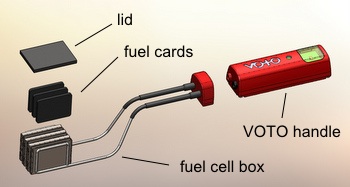If you read this blog often, you may notice a few similarities between Power Practical’s PowerPot thermoelectric power generation devices, and a new solid oxide few cell gadget being offered by a Berkeley National Lab startup company, Point Source Power (PSP).
The applications in mind for both of these power generation systems are generally the same: Can simple, small power generation methods be brought to underdeveloped parts of the world that may lack an electric grid but could benefit greatly from consumer electronics, such as cell phones and LED lighting? According to a story on the Berkeley Lab website, there are about 2.5 billion people that live without grid.
The guts of what PSP is calling its VOTO product is a “groundbreaking metal-supported solid oxide fuel cell (M-SOFC) technology,” that is described as tolerant of all organic fuel types. The point of this is that it can be used in parts of the world that rely on wood, charcoal or even cow dung for heating and cooking purposes.

Credit: Point Source Power.
Essentially, the VOTO has two parts. It has a detachable handle that stores the power from the mini fuel cell. (The part of the handle that detaches contains an LED for lighting and also can be used for recharging purposes.) The handle is attached to the small fuel cell mechanism that actually requires several fuel cell cards (see schematic). As mentioned above, this is actually M-SOFC technology, and these fuel cards are primarily stainless steel, rather than ceramic. PSP calls this system “Votosynthesis.”
The business plan for both Power Practical and PSP causes a little confusion (and numerous troll comments). Both want to make their products available at low cost to the developing and underdeveloped world. But, to accomplish that, they also have to market them to customers in the developed world who might see them as great tools for outdoor enthusiasts, campers, emergencies, etc.
PSP’s CEO Craig Jacobson says in another short YouTube video that consumers in America will have to pay more for the VOTO, but the company intends to use the proceeds from those sales to support sales and distribution in poorer parts regions of the globe. Kenya is said to be the where PSP will first attempt to market VOTO. The handle will sell for about $17 and the replaceable fuel cell cards for $7. The latter is expected to last for three to four months of regular use.
Berkeley Lab says that before helping launching PSP in 2008, Jacobson helped develop the VOTO system while at the institution. The lab reports
Jacobson co-invented the fuel cell in his 13 years as a materials scientist at Berkeley Lab. Working with Steve Visco and Lutgard DeJonghe, both still affiliated with the Lab, their breakthrough was in finding a way to replace most of the ceramics in the fuel cell with stainless steel, a far cheaper and more durable material. “Ceramics are typically brittle and relatively expensive to process and assemble into systems,” Jacobson said. “We got rid of 90 percent of the ceramics, keeping only a very thin functional layer, about half the thickness of human hair, to serve as the electrolyte.”
Jacobson goes on to say, “Fuel cells have been around for over 50 years—they work great. There are only three problems with fuel cells: cost, cost and cost. Our philosophy is, let’s get rid of those costs and make a fuel cell that can run on anything that burns.”
Despite its apparent simplicity, Berkeley Lab says the VOTO ultimately required the licensing of 130 patents.
Although the VOTO isn’t quite as powerful as a PowerPot (~500mA maximum at 5V versus 1A max at 5V), the PowerPot is more expensive (about $125 for the basic 5W pot).
